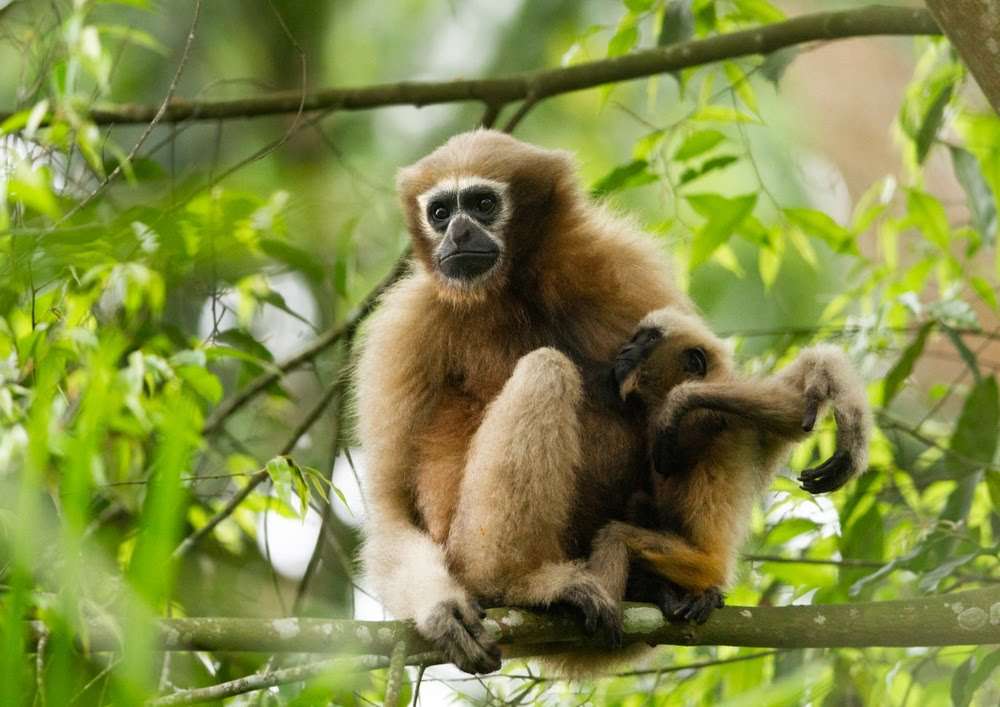By-Avik Chakraborty
Tinsukia, Sept 21: Hoolock Gibbon’s of eastern Assam’s Barekuri region needs state government’s attention but despite several request the government failed to take any conservation step.
Barekuri, just 7 km from Tinsukia City, is regarded as the habitat of Hoolock Gibbon.
Recently, the death of Kalia, a female Hoolock Gibbon in Barekuri, has made media headlines. It has been alleged that the 40-year-old Hoolock Gibbon died due to the negligence of the forest department.
According to the resident, Kalia has been suffering from a mysterious disease for the last few days.
Now, there are a total of 22 Hoolock Gibbons living in the Barekuri area with their families. All of them are familiar with human beings.
Speaking to NE Hub News, Diplob Chutia, a wildlife activist and president of the Barekuri eco-development committee, said, “The government has not taken any positive steps for the conservation of Hoolock Gibbon. We have requested the government and even met with the chief minister to take steps for the conservation of Hoolock Gibbon, but till date no such step has been taken.”.
“Tourists came over from around the world to see the Hoolock Gibbon. Hoolock Gibbon is very popular among tourists. Kalia was very familiar among the tourists. We demand a research centre for Hoolock Gibbon be set up in Barekuri. We have given a proposal to the government for that, but till date, nothing has happened,” Chutia said.
He said, “Among the 22, four male Hoolock Gibbons live separately. The Hoolock Gibbons are beings, like human beings. The people of the Barekuri region love the Hoolock Gibbon and didn’t harm them. The Hoolock Gibbons are very peace-loving creatures and didn’t do any kind of terror-like act, which is done by the other monkeys.”.
‘In 2009, Hoolock Gibbon died of tuberculosis in Barekuri. After the postmortem conducted on Hoolock Gibbon, it was found that he died due to tuberculosis. The postmortem was conducted by WTI doctor Abhijit Bhawal. After the setting up of OIL rigs in the Barekuri area, pollution of the comes out from rig has been causing pollution and harming Gibbon,” Chutia said.
The four villages of Barekuri—Digal Haku, Nau-motapung, Puroni-Motapung, and Lesenga Tarazan—are home to 22 hoolock gibbons.
Earlier, Barekuri had a population of 37 hoolock gibbons but now the number has fallen to 22. Many of them have died of electrocution or after falling from trees.
Hoolock Gibbon is the only species of ape to be found in India, and the evergreen and semi-evergreen forests of the seven states of the Northeast serve as the natural habitats of this endangered species.

Hoolocks are the second-largest of the gibbons, after the siamang.
They reach a size of 60 to 90 CM and weight six to nine kg. Northeast India, the Hoolock are found in south of Brahmaputra and North Bank areas and East of Dibang Rivers.
Its range extends into seven states, covering Arunachal Pradesh, Assam, Manipur, Meghalaya, Mizoram, Nagaland, and Tripura.
In 2015, the International Union for Conservation of Nature (IUCN) declared 2015 the year of the gibbon to raise awareness about the threats gibbons face.
It is feared that gibbons will be one of the next groups of animals to face global extinction in the wild.
“The Hoolock Gibbon of Barekuri village is facing a threat because no conservation policies have been taken up by the government. The endangered species needs immediate attention because it has been dwindling. Due to industrialization, the gas that comes out of OIL India Limited (OIL) poses a threat to the species,” said Devojit Moran, a wildlife activist.
He said, “For the protection of the Hoolock Gibbon, a standard operating procedure (SOP) has been developed. The government should create an emergency response team for the immediate rescue and treatment of the species. A 24-hour veterinary doctor should be appointed to provide immediate treatment to the Hoolock Gibbon.”
Also read: Nagaland: 8 killed, 2 critically injured in road mishap
WATCH:
Find latest news from every corner of Northeast India at hubnetwork.in, your online source for breaking news, video coverage.
Also, Follow us on-
Twitter-twitter.com/nemediahub
Youtube channel- www.youtube.com/@NortheastMediaHub2020
Instagram- www.instagram.com/nemediahub





